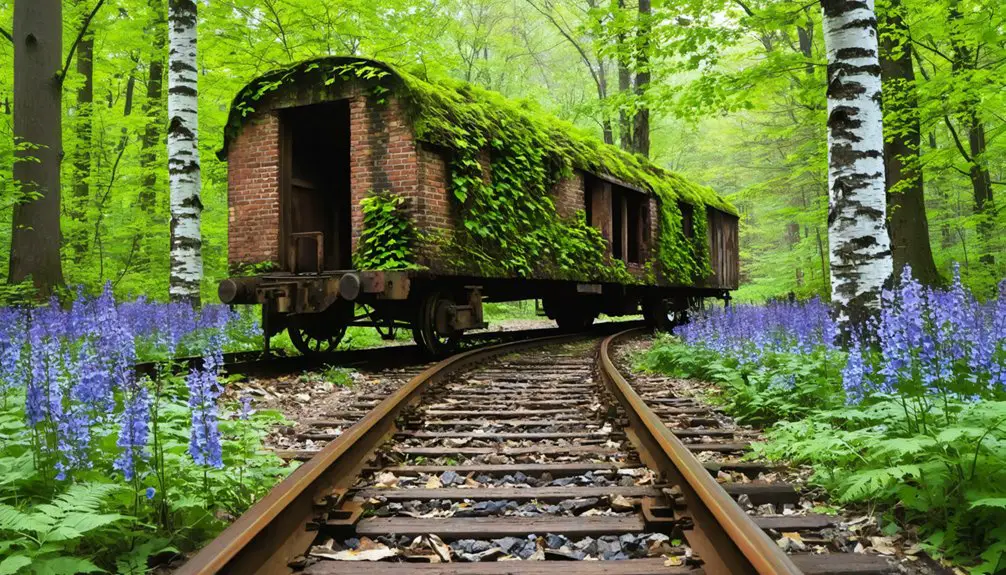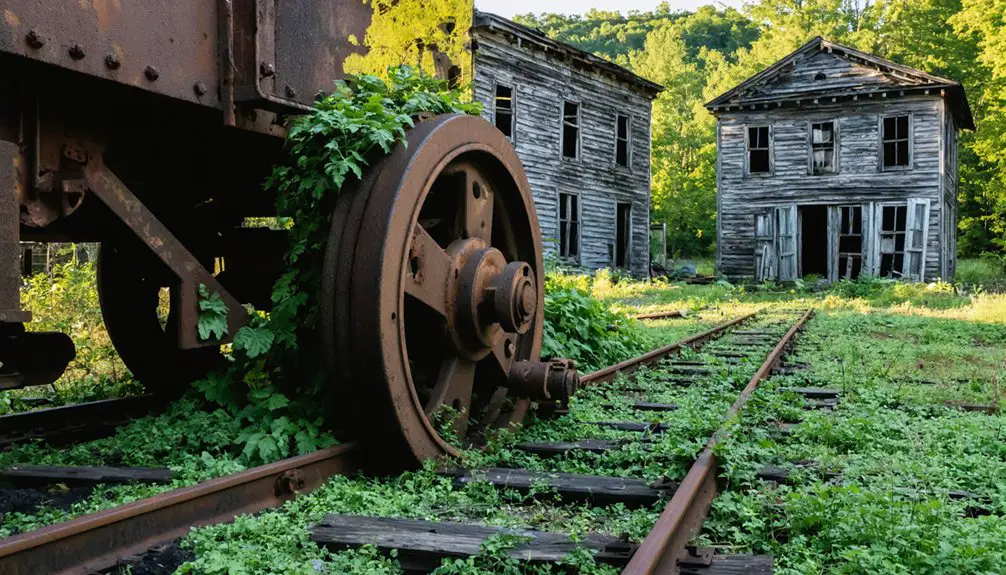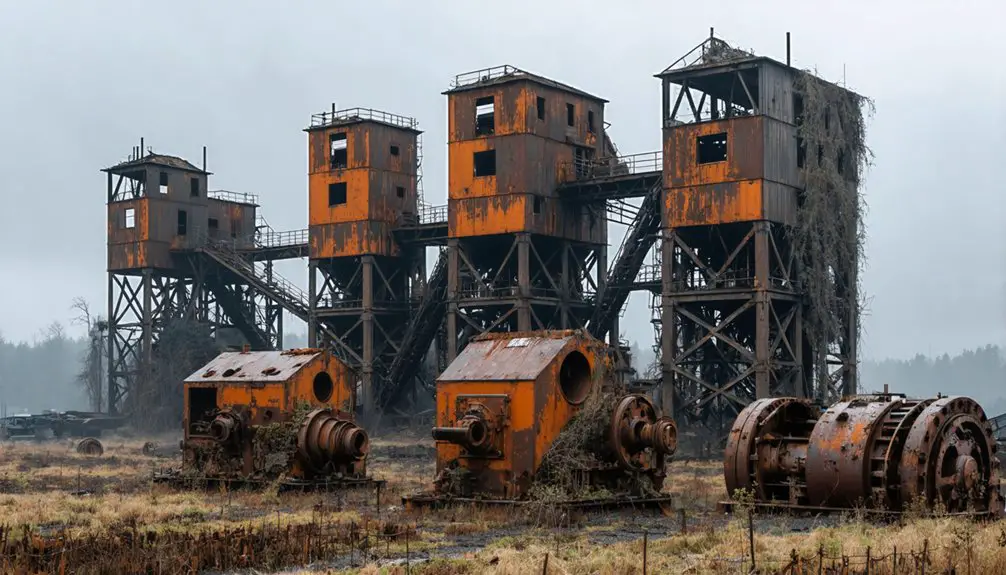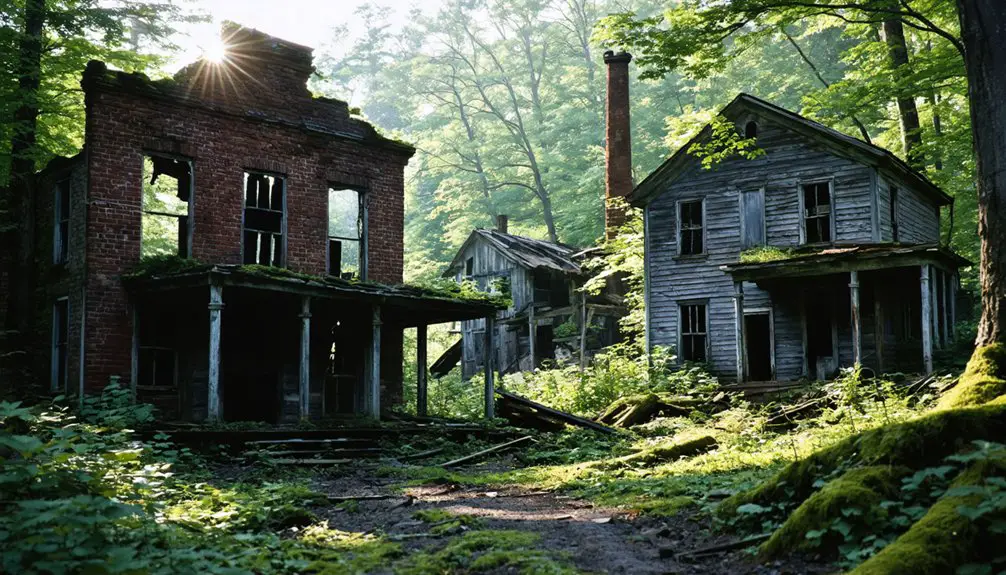You’ll find Hesbon along Pennsylvania’s Ghost Town Trail, where it stands as an abandoned coal mining settlement from the industrial era. The town’s trailhead sits at 1,260 feet elevation near Blairsville, about 8 miles from Black Lick. Once part of Pennsylvania’s thriving coal industry, Hesbon now offers hiking and biking opportunities along crushed limestone paths. Its weathered structures and environmental challenges tell a deeper story of America’s industrial heritage.
Key Takeaways
- Hesbon is an abandoned Pennsylvania ghost town that preserves industrial heritage and reflects America’s manufacturing past through its remaining structures.
- The Hesbon trailhead at 10485 Route 259 serves as an entry point to the Ghost Town Trail, with parking and restrooms available.
- Environmental damage from mining operations near Hesbon includes acid mine drainage and contaminated soils that continue affecting the area today.
- The Ghost Town Trail follows historic railroad routes, connecting former mining communities through 46-49 miles of crushed limestone paths.
- Preservation efforts since the 1980s have documented Hesbon’s industrial structures and historical significance in Pennsylvania’s coal mining history.
A Mining Town’s Rise and Fall
During the 1860s, Centralia emerged as a thriving Pennsylvania coal town, built upon the region’s rich deposits of anthracite coal.
You’ll find the roots of this mining community in pioneering operations like the Locust Run and Coal Ridge mines of 1856, followed by the establishment of the Hazeldell, Centralia, and Continental collieries.
Mining techniques evolved as the town’s population grew to 1,200 residents, showcasing remarkable community resilience despite violent labor conflicts involving the Molly Maguires. The population would eventually reach nearly 2,800 residents by the late 1800s.
The arrival of the Lehigh and Mahanoy Railroad in 1865 transformed Centralia’s economic prospects, connecting its valuable coal reserves to eastern Pennsylvania markets.
Due to its complex history and significance, Centralia became one of several locations requiring place name disambiguation to distinguish it from other similarly named towns.
Location Along the Ghost Town Trail
You’ll find the Hesbon trailhead and parking area at 10485 Route 259 in Blairsville, about 8 miles from the Ghost Town Trail’s western terminus at Black Lick.
The trail follows the former Pennsylvania Railroad right-of-way that once connected the region’s mining communities, including Hesbon, Dilltown, and Vintondale. The access point provides visitors with seasonal portable restrooms for their convenience. Situated at an elevation of 1,260 feet, Hesbon marks a significant point along the trail’s gradual ascent.
As one of several access points along the 36-mile main trail, Hesbon serves as a strategic starting point for exploring both the area’s railroad heritage and the remnants of its coal mining past.
Trailhead Access and Parking
Located at 10485 Route 259 in Blairsville, Pennsylvania, the Heshbon trailhead serves as a key access point along the Ghost Town Trail at an elevation of 1,260 feet.
You’ll find this trailhead about 6.5 miles from the western terminus at Saylor Park, offering excellent hiking accessibility for both casual and serious trail users.
The trail follows the historic route of the 1903 Ebensburg Railroad, providing a glimpse into Pennsylvania’s transportation history.
The trailhead features a dedicated gravel parking area that provides convenient, free parking for your vehicle.
While amenities are basic, you’ll have access to seasonal portable restrooms.
The parking area connects directly to the trail, making it easy to shift from your car to your adventure.
Clear signage guides you to both parking and trail entry points, and you’ll find helpful trail markers and information near the entrance to orient yourself before setting out.
The trail’s gradual 1,000-foot elevation gain heading east offers a challenging but rewarding experience for hikers and cyclists.
Former Railroad Right-of-Way
Established in 1991, the Ghost Town Trail follows the historic Ebensburg and Black Lick Railroad right-of-way, a former Pennsylvania Railroad line that opened in 1903. This essential transportation corridor once served numerous coal mining communities, profoundly shaping the region’s railroad history and community impact. As a testament to its historical importance, the trail is now listed on the Register of Historic Places.
You’ll find the railroad’s legacy preserved through cast iron mile markers, like Mile Marker 37 near the Heshbon Trailhead at MP 5.7. The right-of-way follows Blacklick Creek’s whitewater course, climbing steeply for 6.5 miles from Black Lick to Heshbon. The trail’s crushed limestone surface makes it ideal for both hiking and biking activities.
While passenger service ended in the 1930s as coal mining declined, remnants of the industrial era persist. The corridor passes through several ghost towns, including Wehrum, Claghorn, and Bracken, where you can still spot old bank vaults and other railroad-related artifacts.
Regional Town Connections
Serving as a vital access point along the 36-mile Ghost Town Trail, Heshbon connects multiple historically significant coal mining communities between Black Lick and Ebensburg.
You’ll find Black Lick to the west and Dilltown to the east, with Vintondale, Nanty Glo, and other former mining towns further along the trail system.
Heshbon’s strategic location provides you with a perfect midpoint to explore the region’s rich coal heritage.
The trail features crushed limestone surfaces that make it accessible for both hiking and biking enthusiasts.
The trail connections from this historic stop let you access both the main 32-mile stem and additional extensions, including the C&I Extension and Rexis Branch.
You can trace the paths of former railroad lines that once transported coal through these now-quiet towns, experiencing firsthand how these communities were historically linked through industry and transportation.
The Legacy of Coal Mining Operations
Coal mining’s profound impact on Hesbon and other Pennsylvania towns stretches far beyond mere economic activity.
You’ll find evidence of community resilience in the stories of immigrant miners who faced grueling conditions, working long hours underground while building tight-knit neighborhoods above.
The economic transformation was dramatic – from bustling industrial centers to ghost towns following the industry’s decline. After the Blue Coal bankruptcy in 1976, many mining communities faced devastating economic consequences.
The legacy lives on through the physical remnants of mining operations and the cultural heritage of mining families.
You can trace the evolution from early hand-picking methods to more advanced longwall mining, while the lasting environmental impact remains visible.
The town’s story mirrors many others across Pennsylvania where miners endured cave-ins, explosions, and coal dust exposure, shaping a narrative of both industrial progress and human sacrifice.
Environmental Impact and Recovery

As you walk along Blacklick Creek near Hesbon today, you’ll find a waterway devoid of fish due to the acidic mine drainage from abandoned coal operations.
The environmental damage extends beyond the water, with contaminated soils and vegetation struggling to recover even decades after the mines closed.
While restoration efforts, including constructed wetlands and tree planting initiatives, are working to heal these scars, the recovery process remains slow and challenging due to persistent heavy metal contamination and unstable ground conditions.
Mining’s Legacy on Water
While the landscape around Hesbon bears the visible scars of Pennsylvania’s mining past, the most profound environmental damage lies in its waterways.
You’ll find that decades of uncontrolled acid drainage from abandoned coal mines has devastated the region’s water quality. The mining operations disrupted natural hydrology, permanently altering drainage patterns and groundwater tables throughout the area.
- Heavy metals and acidic discharge continue poisoning streams and aquifers
- Sediment from eroded mine spoils chokes waterways and destroys aquatic habitats
- Contaminated water flows into major systems like the Susquehanna River basin
- Legacy pollution persists despite cleanup efforts starting in the 1960s
These water impacts extend far beyond Hesbon’s boundaries, creating long-term challenges for drinking water, agriculture, and recreation throughout Pennsylvania’s coal country.
Nature’s Slow Healing Process
Despite decades of industrial damage, nature’s resilience shows through in Hesbon’s gradual environmental recovery.
You’ll find pioneer plant species leading the vegetation recovery, as hardy grasses and shrubs take root in the disturbed soil. Though invasive species initially dominate, native plants gradually return through natural succession.
As plants stabilize the exposed earth, wildlife return follows a predictable pattern. You’ll spot small mammals and birds first, with more specialized species appearing as habitat features develop.
The healing process isn’t quick – soil characteristics remain altered from mining activity, and underground fires can still affect local conditions through surface emissions and unstable ground.
But left undisturbed, Hesbon’s landscape slowly transforms as nature reclaims what was once an industrial site.
Connecting Historic Mining Communities
Pennsylvania’s historic mining communities formed an intricate web of interconnected settlements during the late 1700s through the early 1900s, linked by railroads, rivers, and shared cultural bonds.
Community resilience emerged through networks of immigrant laborers who built vibrant cultural identities across regions like Broad Top and the Monongahela Valley. Labor solidarity strengthened as workers united during strikes and wage disputes, particularly in Western Pennsylvania during the 1840s and 1850s.
Immigrant miners forged lasting cultural bonds and worker solidarity across Pennsylvania’s coal regions, uniting communities through shared struggle and resilience.
- The Huntington and Broad Top Mountain Railroad connected rural mining towns to major trade centers after 1853.
- Rivers like the Monongahela served as essential early transportation routes for coal movement.
- Mining communities clustered around coal seams and transportation hubs in Allegheny, Washington, and Westmoreland counties.
- Immigrant workers created mutual aid networks and shared institutions across company towns.
Remnants of a Bygone Era

Modern visitors to Hesbon encounter a landscape marked by nature’s slow reclamation of what was once a bustling mining settlement.
You’ll find scattered concrete foundations, old mine portals, and weathered remnants of company stores that hint at the town’s industrial past. The architectural decay tells a story of rapid abandonment following the 1930s economic downturn.
While most structures have vanished, community memories persist through local cemeteries and artistic tributes.
You can trace the old railroad grade along the Ghost Town Trail, where interpretive signs and granite engravings depict mining life from the 1920s.
Environmental scars remain visible – acid mine drainage stains local streams, and waste piles dot the terrain, serving as stark reminders of the coal industry’s lasting impact on this once-thriving Appalachian community.
Recreational Opportunities Today
Today’s visitors to Hesbon can experience the area’s rich industrial heritage while enjoying extensive recreational opportunities along the Ghost Town Trail.
You’ll find direct access to a 46-49 mile multi-use trail that connects several former coal mining communities, with facilities and amenities at multiple trailheads.
- Hike or bike through scenic landscapes featuring waterfalls, cascades, and lush forests while discovering historical remnants of the region’s coal mining past.
- Explore the preserved Eliza Furnace, a mid-19th century hot blast iron furnace, along your trail activities.
- Take advantage of year-round outdoor adventures, including cross-country skiing in winter.
- Visit nearby Duman Lake County Park and Ebensburg for additional recreational amenities and dining options.
The trail offers numerous rest stops, covered pavilions, and interpretive markers, making your outdoor adventures both comfortable and educational.
The Railroad’s Vital Role

The Ebensburg and Black Lick Railroad transformed Hesbon’s landscape when it opened in 1903, establishing essential transportation links that would shape the town’s destiny.
Opening in 1903, the Ebensburg and Black Lick Railroad reshaped Hesbon by forging vital transportation connections that determined its future path.
As part of the Pennsylvania Railroad system, it revolutionized railroad economics by connecting local mining operations to broader markets, enabling rapid coal transport and town development.
You’ll find that transportation efficiency defined Hesbon’s growth, as the railroad supported multiple mines while fostering the establishment of crucial community infrastructure.
Company stores, schools, and housing sprang up along the tracks, while passenger services connected residents to regional centers until the 1930s.
When coal mining declined, so did the railroad’s importance, ultimately leading to the line’s abandonment.
Today, the Ghost Town Trail follows the former railbed, preserving Hesbon’s transportation heritage through visible remnants and historical markers.
Life in Early 20th Century Heshbon
Life in early twentieth-century Heshbon reflected the struggles of a small rural community grappling with industrial decline. You’d find families living in wooden homes, managing subsistence farms, and dealing with the aftermath of the iron industry’s collapse following the devastating 1865 flood.
The community dynamics revolved around basic survival, with limited infrastructure and minimal access to modern amenities.
- Most residents relied on wells and creeks for water
- Dirt roads and small bridges provided only basic transportation
- One-room schoolhouses offered limited education for children
- Church gatherings served as the primary social connection
Economic struggles defined daily life, with most households depending on farming and remnants of the iron trade.
You’d see men working physical jobs while women maintained households, their children helping with both farming and domestic duties – a reflection of the hardy spirit of rural Pennsylvania life.
Preserving Industrial Heritage

Modern efforts to preserve Heshbon’s industrial legacy gained momentum in the late 1980s as part of southwestern Pennsylvania’s broader heritage conservation movement.
Southwestern Pennsylvania’s heritage conservation movement revitalized interest in preserving Heshbon’s industrial past during the 1980s.
The Southwestern Pennsylvania Heritage Preservation Commission spearheaded documentation initiatives through the America’s Industrial Heritage Project, capturing the town’s role in the region’s industrial development.
You’ll find detailed records of Heshbon’s industrial structures in the Historic American Buildings Survey and Historic American Engineering Record, now housed at the Library of Congress and Indiana University of Pennsylvania archives.
These preservation efforts mirror successful adaptive reuse projects across Pennsylvania, where industrial sites have been transformed into community assets.
While Heshbon remains largely abandoned, its documented industrial heritage contributes to our understanding of Pennsylvania’s manufacturing past and serves as a valuable resource for historians and preservationists studying America’s industrial revolution.
Frequently Asked Questions
What Was the Total Population of Heshbon During Its Peak Mining Years?
You’ll find population growth estimates suggest 1,000-1,500 residents during peak mining years, though exact numbers aren’t documented. The town experienced mining decline by the early 1900s, leading to depopulation.
Are There Any Documented Ghost Stories or Paranormal Activities in Heshbon?
Like a quiet footprint in untouched snow, you won’t find any documented ghost sightings or paranormal investigations in Heshbon. Historical records focus purely on the area’s mining heritage and natural features.
What Were the Typical Wages for Coal Miners in Heshbon?
You’d find coal miner wages in Heshbon matched regional standards of about $4.60 per day in the early 1900s, though your actual take-home pay often dropped due to company store deductions and equipment fees.
Did Native Americans Have Any Settlements in the Heshbon Area?
You’ll find evidence of Native settlements in the area, as Lenape and other tribes established camps along the Susquehanna Valley. The region held cultural significance for hunting and seasonal gatherings.
What Happened to the Original Residents After They Left Heshbon?
Like 70% of displaced mining families, you’d find the former Heshbon residents relocated to nearby Pennsylvania industrial towns, seeking work in steel mills while maintaining their community legacy through oral histories.
References
- https://en.wikipedia.org/wiki/Ghost_Town_Trail
- https://www.youtube.com/watch?v=Qj5LjacccJ0
- https://hikinginpennsylvania.wordpress.com/2011/06/07/ghost-town-trail-black-lick-to-heshbon/
- https://indianacountyparks.org/our-trails/ghost-town-trail/ghost-town-trailheads/
- https://marciabonta.com/2009/01/01/hiking-the-ghost-town-trail/
- https://en.wikipedia.org/wiki/Centralia
- https://priceonomics.com/how-a-pennsylvania-coal-town-became-hell-on-earth/
- https://pabucketlist.com/the-rise-and-fall-of-centralia-pas-toxic-ghost-town/
- https://wynninghistory.com/2019/05/31/centralia-historic-site/
- https://www.cambriaconservationrecreation.com/ghost-town-trail/



